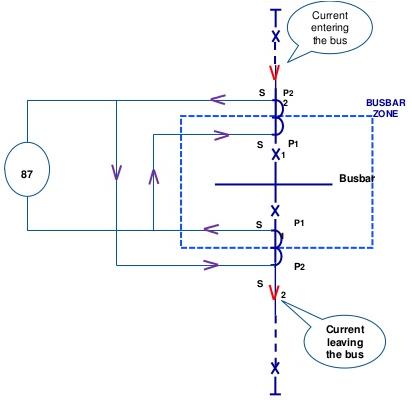Before discussing the types and importance of busbar protections let’s see what is a bus bar? The word bus is derived from Latin word “OMNIBUS” that means common for all, so busbar is actually a common and main part of a power distribution system that serves as nerve center of the power system where various circuits are connected together. Now lets talk about the need for busbar protection but first let’s say some words about the reasons of faults.
There are many reasons for the faults in the bus bar system that may include breakdown of insulation because of over voltages, foreign objects, weakening of insulation because of ageing, corrosion and salty water etc.
Why Electric Busbar Protection is important?
So overcoming the fault condition immediately is very important otherwise fault clearance takes place in zone II of distance relay by remote end tripping. This means slow and unselective tripping and wide spread black out which we are not able to locate easily. Other effects of delayed busbar fault clearance may lead to greater damage at fault point and indirect shock to connected equipment’s to bus bar like shaft of generator and windings of transformer etc. So selection of busbar protection scheme is very critical and it must fulfill below requirements.
- Must have short tripping time as possible.
- Must be able to detect internal faults (sensitivity).
- Must be absolutely stable to external faults (stability).
- Must be able to detect and trip only faulty part of busbar system (selectivity)
- Must be secure against malfunction due to auxiliary contact failure.
Types of Busbar Protection Schemes
Differential busbar protection is the best way of protecting a bus bar which is further divided into two groups.
Low impedance scheme: Low impedance scheme uses biased differential relay.
High impedance Scheme: High impedance scheme uses a stabilizing resistor in series with the differential relay.
Why differential busbar protection is used? Because terminals of the system are near to each other, hence by installing CT’s on the two sides of the busbar, comparison can be made between the current entering it & leaving it. Any difference in current will immediately signal an internal fault. The difference in current can be used to excite the coil of a differential relay via CT secondary and thus issue trip commands to circuit breaker on both sides of the bus to isolate it.
Busbar Differential Protection Relay Principle
Busbar protection relay works on the differential principle i.e. comparing the currents entering and leaving a protected busbar section. If those currents on both sides match the protected object is assumed to be in healthy condition and relay remains stable (non operating). If there is a difference in magnitude of currents, it is assumed that there is some internal fault occurred and the differential relay operates resulting the isolation of faulty bus bar.

When fault is occurred on the bus bar itself. The fault current is contributed by all feeders connected to the bus. Hence, at this condition, sum of all contributed fault current is equal to total fault current. The sum of all secondary currents is no longer zero. It is equal to secondary equivalent of fault current. So at this condition current starts flowing through relay and it makes trip the circuit breaker corresponding to all the feeders connected to this section of the busbar. As all the incoming and outgoing feeders, connected to this section of bus are tripped hence protecting the busbar from any damage.
Discover more from Electrical Engineering 123
Subscribe to get the latest posts sent to your email.

